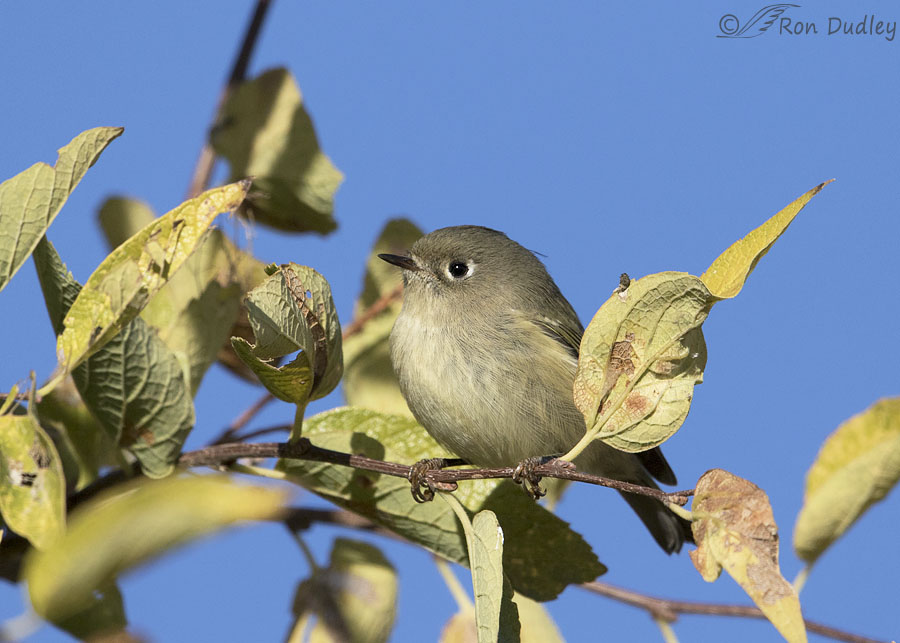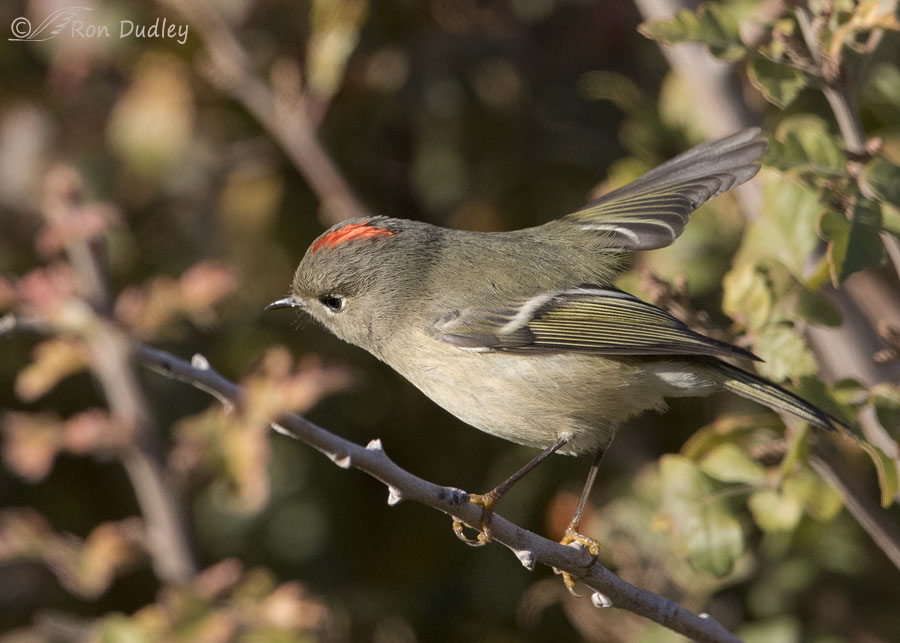I’m pleased anytime I can get decent photos of these secretive little dynamos. Both of these shots were taken a year ago in northern Utah.

1/3200, f/6,3, ISO 500, Canon 7D Mark II, Canon EF 500mm f/4L IS II USM + EF 1.4 III Extender, not baited, set up or called in
Their diminutive size and cryptic coloration makes them extremely difficult to spot in many habitats, including this one. Normally I’d probably complain a little about the leaf in front of the rear of the bird but with this difficult species I’ll hold my tongue.
I’m often surprised by how much color variation I see in their feet. BNA Online says their feet are “medium brown on dorsum of toes. Underside of feet yellow, tinged slightly with orange”. BNA allows for no color variations among individuals, sexes or ages and usually they do if they’re present.
But I see no yellow or orange anywhere on the feet of this bird. The tinge of yellow beneath the right foot is actually the bud of the leaf hanging down beneath it.

1/2500, f/6,3, ISO 800, Canon 7D Mark II, Canon EF 500mm f/4L IS II USM + EF 1.4 III Extender, not baited, set up or called in
But on the same morning this male had feet that were almost entirely yellow-orange which reminded me just a little of the “golden slippers” of Snowy Egrets.
I see this photo as a tradeoff. With his head tilted at this angle I didn’t get a catch light in the eye but that angle allowed me one of my best looks ever at the ruby crown of the species. Only males have it and usually it’s completely hidden deep inside the other feathers of the crown.
We’ve had mostly stormy, cloudy weather for a couple of weeks now so because of poor light it’s now been 13 days since I’ve been out shooting. The upside to our recent weather pattern is that many migrating songbirds have been pushed south or down out of the mountains and into the valleys by the storms. Kinglets and a variety of warblers are among the species being reported and I was really hoping to get back into the field this morning.
But a 4:30 AM look at the satellite and weather radar dashed my hopes. It looks like there’s a band of clouds moving in that will ruin the morning.
When I think about cursing the weather I think about the victims of hurricane Michael and that puts it all in perspective. Best of luck to everyone in the southeast states!
Ron


Excellent shots, Ron. Even as a UCLA alum, I can appreciate the gold feet and red head (USC colors — feh!) of this gorgeous bird!
Thanks, Marty. Whenever I think of USC the first thing that pops into my head is… OJ.
I can think of lots of other stuff, fortunately. 😉
Your keen powers of observation Ron, excellent shots and excellent post!
It makes me ponder on what is causing the change in foot color. Is it caused from its diet? Genetics? An abnormality?
I used to band these fellows, not many, but in all the ones that I remember, (remember now, I’m 82), I don’t remember one with yellow-orange feet.
Very interesting. I hope you send these images to Cornell Lab of Ornithology.
Interesting that you don’t remember seeing yellow feet since you actually had them in hand. Thanks, Dick.
Keen powers of observation + proper equipment = an anatomical feature that perhaps few if any have observed. Good eye! And what a nice look at that crown.
Thanks very much, Lyle.
Beautiful photos, Ron! The only time I’ve been successful photographing these little gems is when I’ve had the good luck of catching them while preening after a bath. Otherwise all of my shots are perches- with no bird in sight, or just a portion of a blurry tail as the bird flew off!
Ha, I’ve taken more than my share of those perch shots, Diana. With this species they’re the rule rather than the exception…
I love that second shot! It’s a beautiful pose. With birds as small and flitty as Ruby Crowned Kinglets, it blew me away to see the title of this post. Clearly, from your photos, there is coloration difference between birds. I think I was watching a Ruby Crowned Kinglet in the park the last time I was supposed to be telling a story, and the bird was in such constant motion that only the size and activity gave away what it was (I couldn’t really see the color).
Yup, they personify the word “flitty”, Susan – hyperactive little bundles of energy. That’s a big part of why they’re so very difficult to photograph.
Interesting…didn’t know there would be any variation…nice images!!
Thank you, Patty.
Nice photos Ron. Your weather has worked its way down here. I was lying in bed thinking that I will wait till this afternoon to go take some eagle shots instead of my usual early morning ventures. Got up, opened the back sliding door to let my dog out, and sure enough it was raining. So much for my plans. What’s the saying, “Best laid plans of mice and men”?
Everett Sanborn, Prescott AZ
“Best laid plans of mice and men”?
Yup, Robert Burns got that right over 200 years ago and it remains valid today, especially for bird photographers! Thanks, Everett.
Wonderful shots Ron! Thanks for sharing!
Charlotte
Thank you, Charlotte.
The 2nd photo is great for showing of “features”, including the crown of the bird. 🙂 The bits of yellow in the wings show well and aren’t that noticeable with a quick glance in the field 😉 Yes, weather has not been conducive to being “out there” BUT not complaining TOO much since we don’t have “Michael” to deal with! You must be feeling better……….?
Thanks, Judy. Sometimes I think I am and then it all comes back. Maddening…